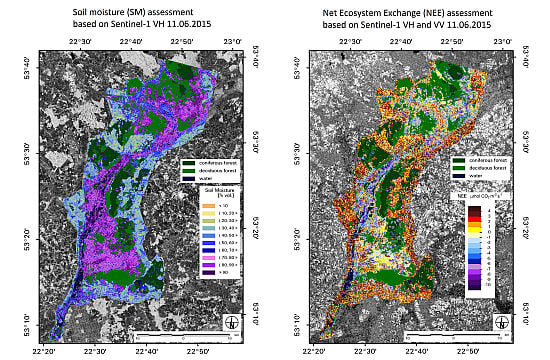Assessment of Carbon Flux and Soil Moisture in Wetlands Applying Sentinel-1 Data
Abstract
:1. Introduction
- Classification of the wetland vegetation habitat types based on optical and microwave satellite images.
- Developing models for soil moisture assessment applying σ° calculated from Sentinel-1 data.
- Examination of influence of LAI and soil moisture on σ° calculated from Sentinel-1 data.
- Developing NEE models applying σ° calculated from Sentinel-1 VH and VV data.
- Mapping spatial distribution of NEE over a test site area.
2. Materials and Methods
2.1. Test Site
2.2. Data Sets
2.3. Methods
3. Results
3.1. Classification of Wetland Vegetation Habitats
3.2. Soil Moisture
3.3. Influence of LAI and Soil Moisture on σ° Calculated from Sentinel-1 Data.
3.4. NEE Modeling
4. Discussion
4.1. Classification of Wetland Vegetation Habitat Types
4.2. Soil Moisture
4.3. Influence of LAI and Soil Moisture on σ° Calculated from Sentinel-1 Data.
4.4. NEE Modeling
5. Conclusions
- (1)
- Wetland vegetation habitats have been classified using a combination of one optical (i.e., Landsat 8 OLI) and three microwave (i.e., TerraSar-X VV) images. The remote sensing based classification distinguished several wetlands’ non-forest classes that have not been noticed before, which is novel.
- (2)
- Soil moisture could be assessed using Sentinel-1 data acquired in VH polarisation. However, these preliminary results have to be validated and models corrected using new acquisitions. Also, if available in the future, S1 HH polarisation will be included for SM modelling.
- (3)
- There is the influence of soil moisture and vegetation biomass represented by LAI on σ° VH, however soil moisture impact on backscatter is stronger.
- (4)
- Comparing the results of model (2) and model (3), it has to be noted that the influence of LAI on σ° VH value is much stronger when soil moisture is low.
- (5)
- NEE in-situ measurements had positive values during dry soil conditions and low biomass means that CO2 was released into the atmosphere. Also, when dry vegetation was over the water table in the flooded area, NEE values were positive. For the wet soil moisture conditions and high biomass, CO2 absorption dominated (NEE negative values).
- (6)
- NEE could be assessed by applying combined Sentinel-1 VV and VH data. However, to obtain better accuracy, statistical correlation should be improved. These preliminary results will be validated and the model corrected by applying new satellite acquisitions and in-situ data.
Acknowledgments
Author Contributions
Conflicts of Interest
Abbreviations
| ALOS | Advanced Land Observing Satellite |
| ANN | Artificial Neural Network |
| ASAR | Advanced Synthetic Aperture Radar onboard ENVISAT satellite |
| BNP | Biebrza National Park |
| Bw | wet biomass |
| CCI | Climate Change Initiative |
| CO2 | carbon dioxide |
| Eddy Covariance | atmospheric measurement technique to measure and calculate vertical turbulent fluxes |
| ENL | Effective Number of Looks |
| ENVISAT | ESA’s Environmental Satellite |
| ERS-1/2 SAR | ESA’s two European Remote Sensing satellites |
| ESA | European Space Agency |
| GEC | Geocoded Elipsoid Corrected |
| GRD | Ground Range Detected |
| GPP | Gross Primary Production |
| HH | Horizontal Transmit/Horizontal Receive—like polarisation |
| HV | Horizontal Transmit/Vertical Receive—cross polarisation |
| IEM | Integral Equation Model |
| IS2 | ASAR swath (look angle 19.2°–26.7°) |
| IS6 | ASAR swath (look angle 39.1°–42.8°) |
| IW | Interferometric Wide mode of Sentinel-1 |
| JERS-1 | Japanese Earth Resources Satellite-1 |
| LAI | Leaf Area Index |
| Landsat 8 | American Earth observation satellite, the eighth in the Landsat program |
| Landsat TM | Landsat Thematic Mapper satellite |
| Landsat ETM+ | Landsat Enhanced Thematic Mapper Plus satellite |
| MBE | Mean Biass Error |
| MERIS | Medium Spectral Resolution Imaging Spectrometer |
| MODIS | Moderate-Resolution Imaging Spectroradiometer onboard Terra satellite |
| NDVI | Normalised Difference Vegetation Index |
| NEE | Net Ecosystem Exchange |
| OLI | Operational Land Imager onboard Landsat 8 satellite |
| PALSAR | Phased Array type L-band Synthetic Aperture Radar |
| PAR | Photosynthetically Active Radiation |
| PUWG1992 | Polish local projection (Państwowy Układ Współrzędnych Geodezyjnych 1992) |
| R | correlation coefficient |
| R2 | coefficient of determination |
| RESP | Ecosystem Respiration |
| RGB | Red, Green, Blue spectral wave used for generation of composite imagery |
| RMSE | Root Mean Square Error |
| SAR | Synthetic Aperture Radar |
| S1 | acronym of Sentinel-1 |
| S1TBX | ESA’s Sentinel-1 Toolbox |
| ScanSAR | SAR imaging mode |
| Sentinel-1 | European Radar Observatory, the first in the series of ESA’s satellites within the Copernicus Programme |
| SM | soil moisture |
| SNAP | Sentinel Application Platform |
| StripMap | SAR imaging mode |
| TDR | Time Domain Reflectometry |
| TerraSAR-X (TSX) | a radar Earth observation satellite, a joint venture being carried out under a public-private-partnership between the German Aerospace Center (DLR) and EADS Astrium |
| TOA | Top of Atmosphere |
| TSX | acronym of TerraSAR-X |
| UTM | Universal Transverse Mercator |
| VV | Vertical Transmit/Vertical Receive—like polarisation |
| VH | Vertical Transmit/Horizontal Receive—cross polarisation |
| σ° | backscattering coefficient [dB] |
References
- Mitsch, W.J.; Gosselink, J.G. Wetlands: Human History, Use, and Science. In Wetlands, 4th ed.; John Wiley & Sons Inc.: Hoboken, NJ, USA, 2007; pp. 3–5. [Google Scholar]
- Wu, J.; Roulet, N.T. Climate change reduces the capacity of northern peatlands to absorb the atmospheric carbon dioxide: The different responses of bogs and fens. Glob. Biogeochem. Cycles 2014, 28, 1005–1024. [Google Scholar] [CrossRef]
- Mitsch, W.J.; Bernal, B.; Nahlik, A.M.; Mander, U.; Zhang, L.; Anderson, C.J.; Jorgensen, S.E.; Brix, H. Wetlands, carbon, and climate change. Landsc. Ecol. 2013, 28, 583–597. [Google Scholar] [CrossRef]
- Blundell, A.; Holden, J. Using palaeoecology to support blanket peatland management. Ecol. Indic. 2015, 49, 110–120. [Google Scholar] [CrossRef]
- Mudge, P.L.; Wallace, D.F.; Rutledge, S.; Campbell, D.I.; Schipper, L.A.; Hosking, C.L. Carbon balance of an intensively grazed temperate pasture in two climatically contrasting years. Agric. Ecosyst. Environ. 2011, 144, 271–280. [Google Scholar] [CrossRef]
- Acharya, B.R.; Rasmussen, J.; Eriksen, J. Grassland carbon sequestration and emissions following cultivation in a mixed crop rotation. Agric. Ecosyst. Environ. 2012, 153, 33–39. [Google Scholar] [CrossRef]
- Felber, R.; Neftel, A.; Ammann, C. Discerning the cows from the pasture: Quantifying and partitioningthe NEE of a grazed pasture using animal position data. Agri. For. Meteorol. 2016, 216, 37–47. [Google Scholar] [CrossRef]
- Scott, R.L.; Huxman, T.E.; Williams, D.G.; Goodrich, D.C. Ecohydrological impacts of woody-plant encroachment: Seasonal patterns of water and carbon dioxide exchange within a semiarid riparian environment. Glob. Chang. Biol. 2006, 12, 311–324. [Google Scholar] [CrossRef]
- Loescher, H.W.; Law, B.E.; Mahrt, L.; Hollinger, D.Y.; Campbell, J.; Wofsy, S.C. Uncertainties in, and interpretation of, carbon flux estimates using the eddy covariance technique. J. Geophys. Res. 2006, 111, 1–19. [Google Scholar] [CrossRef]
- Lasslop, G.; Reichstein, M.; Papale, D.; Richardson, A.D.; Arneth, A.; Barr, A.; Stoy, P.; Wohlfahrt, G. Separation of net ecosystem exchange into assimilation and respiration using a light response curve approach: Critical issues and global evaluation. Glob. Chang. Biol. 2010, 16, 187–208. [Google Scholar] [CrossRef]
- Riederer, M.; Serafimovich, A.; Foken, T. Net ecosystem CO2 exchange measurements by the closed chamber method and the eddy covariance technique and their dependence on atmospheric conditions. Atmos. Meas. Tech. 2014, 7, 1057–1064. [Google Scholar] [CrossRef]
- Pawlak, W.; Fortuniak, K.; Siedlecki, M. Carbon dioxide flux in the centre of Łódź, Poland—Analysis of a 2-year eddy covariance measurement data set. Int. J. Climatol. 2011, 31, 232–243. [Google Scholar] [CrossRef]
- Turbiak, J.; Miatkowski, Z. Emisja CO2 z gleb pobagiennych w zależności od warunków wodnych siedlisk. Water Environ. Rural Areas 2010, 10, 201–210. [Google Scholar]
- Meyers, T.P. A comparison of summertime water and CO2 fluxes over rangeland for well watered and drought conditions. Agric. For. Meteorol. 2001, 106, 205–214. [Google Scholar] [CrossRef]
- Revill, A.; Sus, O.; Barrett, B.; Williams, M. Carbon cycling of European croplands: A framework for the assimilation of optical and microwave Earth observation data. Remote Sens. Environ. 2013, 137, 84–93. [Google Scholar] [CrossRef]
- Gilmanov, T.G.; Soussana, J.F.; Aires, L.; Allard, V.; Ammann, C.; Balzarolo, M.; Barcza, Z.; Bernhofer, C.; Campbell, C.L.; Cernusca, A.; et al. Partitioning European grassland net ecosystem CO2 exchange into gross primary productivity and ecosystem respiration using light response function analysis. Agric. Ecosyst. Environ. 2007, 121, 93–120. [Google Scholar] [CrossRef]
- Rutledge, S.; Mudge, P.L.; Wallace, D.F.; Campbell, D.I.; Woodward, S.L.; Wall, A.M.; Schipper, L.A. CO2 emissions following cultivation of a temperate permanent pasture. Agric. Ecosyst. Environ. 2014, 184, 21–33. [Google Scholar] [CrossRef]
- Kluber, L.A.; Miller, J.O.; Ducey, T.F.; Hunt, P.G.; Lang, M.; Ro, K.S. Multistate assessment of wetland restoration on CO2 and N2O emissions and soil bacterial communities. Appl. Soil Ecol. 2014, 76, 87–94. [Google Scholar] [CrossRef]
- Wagle, P.; Xiao, X.; Torn, M.S.; Cook, D.R.; Matamala, R.; Fischer, M.L.; Jin, C.; Dong, J.; Biradar, C. Sensitivity of vegetation indices and gross primary production of tallgrass prairie to severe drought. Remote Sens. Environ. 2014, 152, 1–14. [Google Scholar] [CrossRef]
- Turner, D.P.; Ritts, W.D.; Cohen, W.B.; Maeirsperger, T.K.; Gower, S.T.; Kirschbaum, A.A.; Running, S.W.; Zhao, M.; Wofsy, S.C.; Dunn, A.L.; et al. Site-level evaluation of satellite-based global terrestrial gross primary production and net primary production monitoring. Glob. Chang. Biol. 2005, 11, 666–684. [Google Scholar] [CrossRef]
- Potter, C.S.; Randerson, J.T.; Field, C.B.; Matson, P.A.; Vitousek, P.M.; Mooney, H.A.; Klooster, S.A. Terrestrial ecosystem production: A process model based on global satellite and surface data. Glob. Biogeochem. Cycles 1993, 7, 811–841. [Google Scholar] [CrossRef]
- Zhang, R. Estimation of Land-Atmosphere Carbon Exchange, Combining Remote Sensing, Modeling and CO2 Flux Data; School of Geosciences, University of Edinburgh: Edinburgh, UK, 2005. [Google Scholar]
- Alton, P.B. The sensitivity of models of gross primary productivity to meteorological and leaf area forcing: A comparison between a Penman-Monteith ecophysiological approach and the MODIS Light-Use Efficiency algorithm. Agric. For. Meteorol. 2016, 218–219, 11–24. [Google Scholar] [CrossRef]
- Englhart, S.; Keuck, V.; Siegert, F. Aboveground biomass retrieval in tropical forests—The potential of combined X- and L-band SAR data use. Remote Sens. Environ. 2011, 115, 1260–1271. [Google Scholar] [CrossRef]
- Dabrowska-Zielinska, K.; Inoue, Y.; Kowalik, W.; Gruszczynska, M. Inferring the effect of plant and soil variables on C-and L-band SAR backscatter over agricultural fields, based on model analysis. Adv. Space Res. 2007, 39, 139–148. [Google Scholar] [CrossRef]
- Wagner, W.; Pathe, C.; Doubkova, M.; Sabel, D.; Bartsch, A.; Hasenauer, S.; Blöschl, G.; Scipal, K.; Martínez-Fernández, H.; Löw, W. Temporal Stability of Soil Moisture and Radar Backscatter Observed by the Advanced Synthetic Aperture Radar (ASAR). Sensors 2008, 8, 1174–1197. [Google Scholar] [CrossRef]
- Joseph, A.T.; van der Velde, R.; O’Neill, P.E.; Lang, R.; Gish, T. Effects of corn on C- and L-band radar backscatter: A correction method for soil moisture retrieval. Remote Sens. Environ. 2010, 114, 2417–2430. [Google Scholar] [CrossRef]
- Santi, E.; Paloscia, S.; Pettinato, S.; Notarnicola, C.; Pasolli, L.; Pistocchi, A. Comparison between SAR Soil Moisture Estimates and Hydrological Model Simulations over the Scrivia Test Site. Remote Sens. 2013, 5, 4961–4976. [Google Scholar] [CrossRef]
- Mattia, F.; Satalino, G.; Pauwels, V.R.N.; Loew, A. Soil moisture retrieval through a merging of multi-temporal L-band SAR data and hydrologic modelling. Hydrol. Earth Syst. Sci. 2009, 13, 343–356. [Google Scholar] [CrossRef]
- Santi, E.; Paloscia, S.; Pettinato, S.; Fontanelli, G. Application of artificial neural networks for the soil moisture retrieval from active and passive microwave spaceborne sensors. Int. J. Appl. Earth Obs. Geoinf. 2016, 48, 61–73. [Google Scholar] [CrossRef]
- Baghdadi, N.; Cresson, R.; El Hajj, M.; Ludwig, R.; La Jeunesse, I. Estimation of soil parameters over bare agriculture areas from C-band polarimetric SAR data using neural networks. Hydrol. Earth Syst. Sci. 2012, 16, 1607–1621. [Google Scholar] [CrossRef]
- Baghdadi, N.; El Hajj, M.; Zribi, M.; Fayad, I. Coupling SAR C-band and optical data for soil moisture and leaf area index retrieval over irrigated grasslands. IEEE JSTARS 2016, 9, 1229–1243. [Google Scholar] [CrossRef]
- Ulaby, F.T.; Moore, R.K.; Fung, A.K. From Theory to Applications. In Microwave Remote Sensing. Active and Passive; Artech House: Norwood, MA, USA, 1986; Volume 3, pp. 1065–2162. [Google Scholar]
- Zribi, M.; Baghdadi, N.; Holah, N.; Fafin, O. New methodology for soil surface moisture estimation and its application to ENVISAT-ASAR multi-incidence data inversion. Remote Sens. Environ. 2005, 96, 485–496. [Google Scholar] [CrossRef]
- Paloscia, S.; Pampaloni, P.; Pettinato, S.; Poggi, P.; Santi, E. The retrieval of soil moisture from ENVISAT/ASAR data. Earsel eProc. 2005, 4, 44–51. [Google Scholar]
- Paloscia, S.; Pampaloni, P.; Pettinato, S.; Santi, E. A Comparison of Algorithms for Retrieving Soil Moisture from ENVISAT/ASAR Images. IEEE Trans. Geosci. Remote Sens. 2008, 46, 3274–3284. [Google Scholar] [CrossRef]
- Paloscia, S.; Pampaloni, P.; Pettinato, S.; Santi, E. Generation of soil moisture maps from ENVISAT/ASAR images in mountainous areas: A case study. Int. J. Remote Sens. 2010, 31, 2265–2276. [Google Scholar] [CrossRef]
- Balenzano, A.; Mattia, F.; Satalino, G.; Davidson, M.W.J. Dense Temporal Series of C- and L-band SAR Data for Soil Moisture Retrieval over Agricultural Crops. IEEE J. Sel. Top. Appl. Earth Obs. 2011, 4, 439–450. [Google Scholar] [CrossRef]
- Mattia, F.; Le Toan, T.; Picard, G.; Posa, F.I.; D’Alessio, A.; Notarnicola, C.; Gatti, A.M.; Rinaldi, M.; Satalino, G.; Pasquariello, G. Multitemporal C-band radar measurements on wheat fields. IEEE Trans. Geosci. Remote Sens. 2003, 41, 1551–1560. [Google Scholar] [CrossRef]
- Turbiak, J. Carbon balance in grassland ecosystem on a moderately decomposed peat-muck soil. Water Environ. Rural Areas 2012, 12, 281–294. [Google Scholar]
- Song, C.; Woodcock, C.E.; Seto, K.C.; Lenney, M.P.; Macomber, S.A. Classification and Change Detection Using Landsat TM Data: When and How to Correct Atmospheric Effects? Remote Sens. Environ. 2001, 75, 230–244. [Google Scholar] [CrossRef]
- Mosier, A.R.; Mack, L. Gas-chromatographic system for precise, rapid analysis of nitrous-oxide. Soil Sci. Soc. Am. J. 1980, 44, 1121–1123. [Google Scholar] [CrossRef]
- Dabrowska-Zielinska, K.; Budzynska, M.; Tomaszewska, M.; Bartold, M.; Gatkowska, M.; Malek, I.; Turlej, K.; Napiorkowska, M. Monitoring Wetlands Ecosystems Using ALOS PALSAR (L-Band, HV) Supplemented by Optical Data: A Case Study of Biebrza Wetlands in Northeast Poland. Remote Sens. 2014, 6, 1605–1633. [Google Scholar] [CrossRef]
- Dabrowska-Zielinska, K.; Budzynska, M.; Lewinski, S.; Hoscilo, A.; Bojanowski, J. Application of remote and in situ information to the management of wetlands in Poland. J. Environ. Manag. 2009, 90, 2261–2269. [Google Scholar] [CrossRef] [PubMed]
- Kayastha, N.; Thomas, V.; Galbraith, J.; Banskota, A. Monitoring Wetland Change Using Inter-Annual Landsat Time-Series Data. Wetlands 2012, 32, 1149–1162. [Google Scholar] [CrossRef]
- Murphy, P.N.C.; Ogilvie, J.; Connor, K.; Arp, P.A. Mapping wetlands: A comparison of two different approaches for New Brunswick, Canada. Wetlands 2007, 27, 845–854. [Google Scholar] [CrossRef]
- Landmann, T.; Schramm, M.; Colditz, R.R.; Dietz, A.; Dech, S. Wide area wetland mapping in semi-arid Africa using 250-meter MODIS metrics and topographic variables. Remote Sens. 2010, 2, 1751–1766. [Google Scholar] [CrossRef]
- Wright, C.; Gallant, A. Improved wetland remote sensing in Yellowstone National Park using classification trees to combine TM imagery and ancillary environmental data. Remote Sens. Environ. 2007, 107, 582–605. [Google Scholar] [CrossRef]
- Evans, T.L.; Costa, M. Landcover classification of the Lower Nhecolândia subregion of the Brazilian Pantanal Wetlands using ALOS/PALSAR, RADARSAT-2 and ENVISAT/ASAR imagery. Remote Sens. Environ. 2013, 128, 118–137. [Google Scholar] [CrossRef]
- Evans, T.L.; Costa, M.; Tomas, W.M.; Camilo, A.R. Large-scale habitat mapping of the Brazilian Pantanal wetland: A synthetic aperture radar approach. Remote Sens. Environ. 2014, 155, 89–108. [Google Scholar] [CrossRef]
- Santoro, M.; Pantze, A.; Fransson, J.E.S.; Dahlgren, J.; Persson, A. Nation-wide clear-cut mapping in Sweden using ALOS PALSAR strip images. Remote Sens. 2012, 4, 1693–1715. [Google Scholar] [CrossRef]
- Cornforth, W.A.; Fatoyinbo, T.E.; Freemantle, T.P.; Pettorelli, N. Advanced land observing satellite phased array type L-band SAR (ALOS PALSAR) to inform the conservation of mangroves: Sundarbans as a case study. Remote Sens. 2013, 5, 224–237. [Google Scholar] [CrossRef]
- Flores De Santiago, F.; Kovacs, J.M.; Lafrance, P. An object-oriented classification method for mapping mangroves in Guinea, West Africa, using multipolarized ALOS PALSAR L-band data. Int. J. Remote Sens. 2013, 34, 563–586. [Google Scholar] [CrossRef]
- Bwangoy, J.R.; Hansen, M.C.; Roy, D.P.; De Grandi, G.; Justice, C.O. Wetland mapping in the Congo Basin using optical and radar remotely sensed data and derived topographical indices. Remote Sens. Environ. 2010, 114, 73–86. [Google Scholar] [CrossRef]
- Ozesmi, S.L.; Bauer, M.E. Satellite remote sensing of wetlands. Wetl. Ecol. Manag. 2002, 10, 381–402. [Google Scholar] [CrossRef]
- Barrett, B.W.; Dwyer, E.; Whelan, P. Soil moisture retrieval from active spaceborne microwave observations: An evaluation of current techniques. Remote Sens. 2009, 1, 210–242. [Google Scholar] [CrossRef]
- Baghdadi, N.; Holah, N.; Zribi, M. Soil moisture estimation using multi-incidence and multi-polarization ASAR data. Int. J. Remote Sens. 2006, 27, 1907–1920. [Google Scholar] [CrossRef]
- Reschke, J.; Bartsch, A.; Schlaffer, S.; Schepaschenko, D. Capability of C-band SAR for operational wetland monitoring at high latitudes. Remote Sens. 2012, 4, 2923–2943. [Google Scholar] [CrossRef]
- Bartsch, A.; Kidd, R.; Scipal, K.; Wagner, W. Satellite radar imagery for monitoring inland wetlands in boreal and sub-arctic environments. Aquat. Conserv. Mar. Freshw. Ecosyst. 2007, 17, 305–317. [Google Scholar] [CrossRef]
- Kasischke, E.S.; Bourgeau-Chavez, L.L.; Rober, A.R.; Wyatt, K.H.; Waddington, J.M.; Turetsky, M.R. Effects of soil moisture and water depth on ERS SAR backscatter measurements from an Alaskan wetland complex. Remote Sens. Environ. 2009, 113, 1868–1873. [Google Scholar] [CrossRef]
- Paloscia, S.; Pettinato, S.; Santi, E.; Notarnicola, C.; Pasolli, L.; Reppucci, A. Soil moisture mapping using Sentinel-1 images: Algorithm and preliminary validation. Remote Sens. Environ. 2013, 134, 234–248. [Google Scholar] [CrossRef]
- Kornelsen, K.C.; Coulibaly, P. Advances in soil moisture retrieval from synthetic aperture radar and hydrological applications. J. Hydrol. 2013, 476, 460–489. [Google Scholar] [CrossRef]
- Hornacek, M.; Wagner, W.; Sabel, D.; Truong, H.L.; Snoeij, P.; Hahmann, T.; Diedrich, E.; Doubková, M. Potential for high resolution systematic global surface soil moisture retrieval via change detection using Sentinel-1. IEEE J. Sel. Top. Appl. 2012, 5, 1303–1311. [Google Scholar] [CrossRef]
- Dorigo, W.A.; Gruber, A.; De Jeu, R.A.M.; Wagner, W.; Stacke, T.; Loew, A.; Albergel, C.; Brocca, L.; Chung, D.; Parinussa, R.M.; et al. Evaluation of the ESA CCI soil moisture product using ground based observations. Remote Sens. Environ. 2015, 162, 380–395. [Google Scholar] [CrossRef]
- Dabrowska-Zielinska, K.; Budzynska, M.; Kowalik, W.; Malek, I.; Gatkowska, M.; Bartold, M.; Turlej, K. Biophysical parameters assessed from microwave and optical data. Int. J. Electron. Telecommun. 2012, 58, 99–104. [Google Scholar] [CrossRef]
- Dabrowska-Zielinska, K.; Budzynska, M.; Kowalik, W.; Małek, I.; Turlej, K. Characterizing status of selected ecosystems using optical and microwave remote sensing data. In Proceedings of the ESA Living Planet Symposium, Bergen, Norway, 28 June 2010–2 July 2010.
- Dabrowska-Zielinska, K.; Gruszczynska, M.; Kowalik, W.; Hoscilo, A.; Stankiewicz, K. Retrieval of crop-soil parameters from ENVISAT ASAR data for agriculture area. In Proceedings of the 4th International Symposium on the Retrieval of Bio- and Geophysical Parameters from SAR Data for Land Applications, Innsbruck, Austria, 16–19 November 2004; pp. 63–70.
- Budzynska, M.; Dabrowska-Zielinska, K.; Tomaszewska, M.; Bartold, M.; Gatkowska. Studies on carbon exchange in grassland areas. Grassl. Sci. Pol. 2015, 18, 47–58. [Google Scholar]
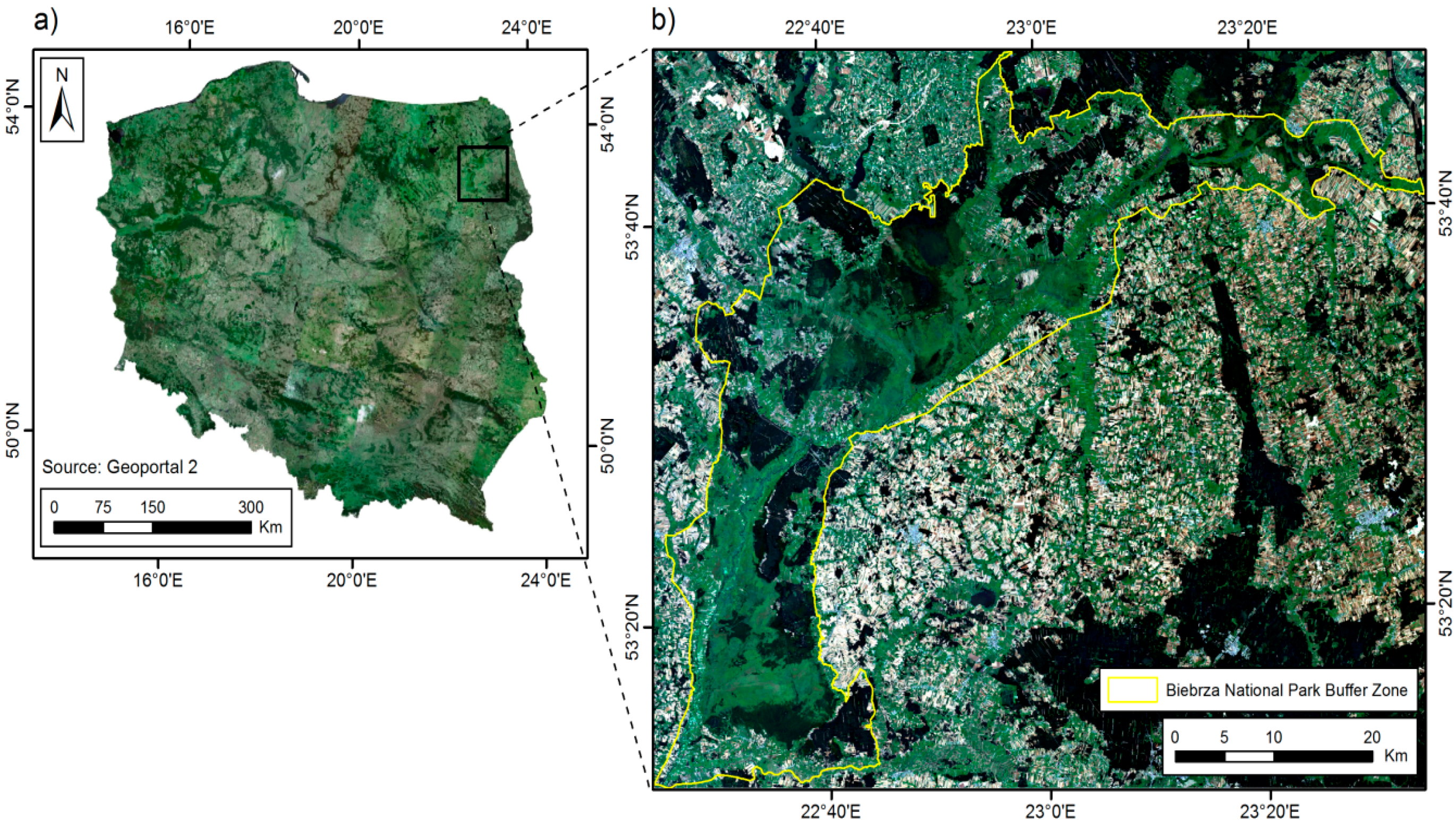
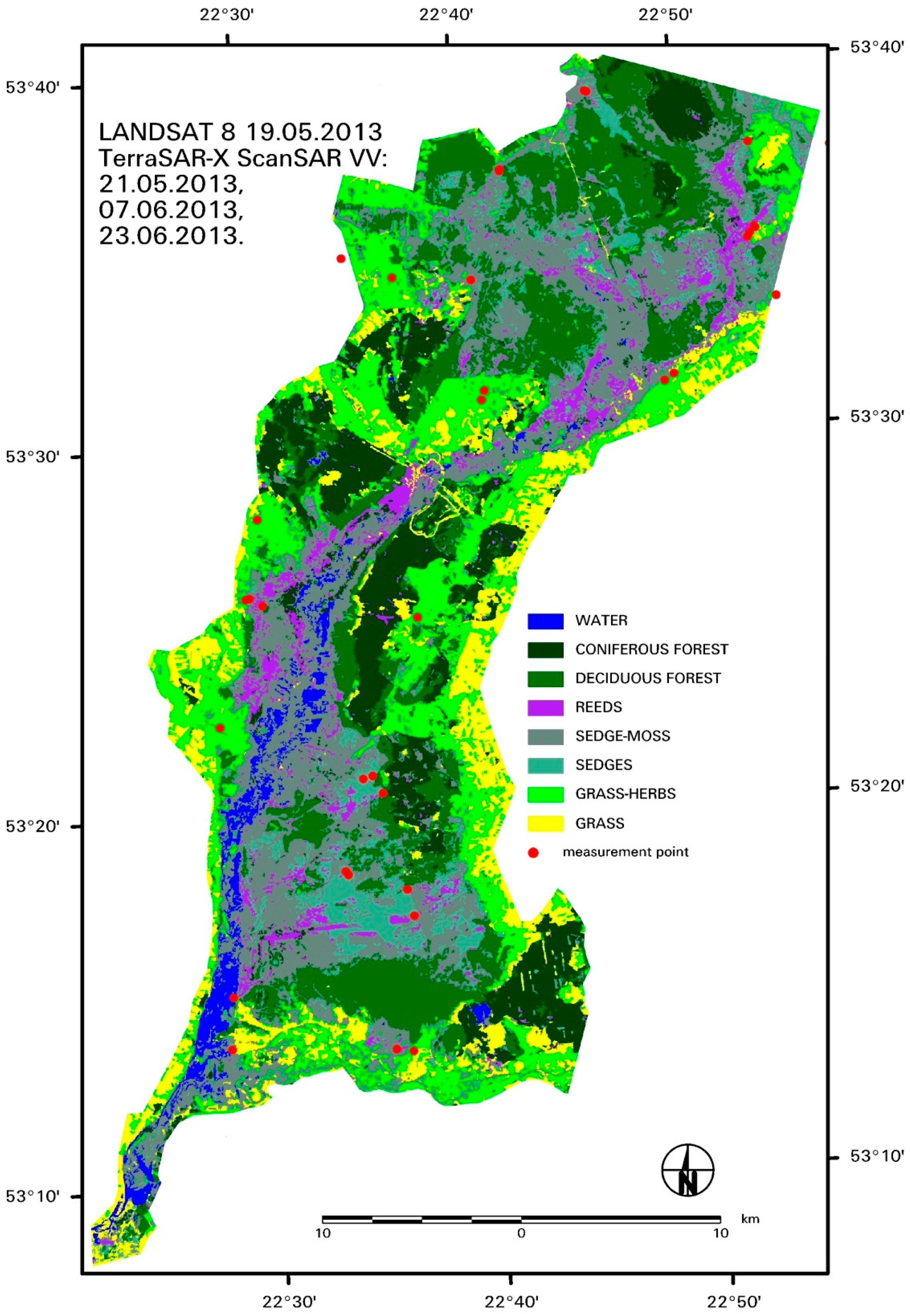



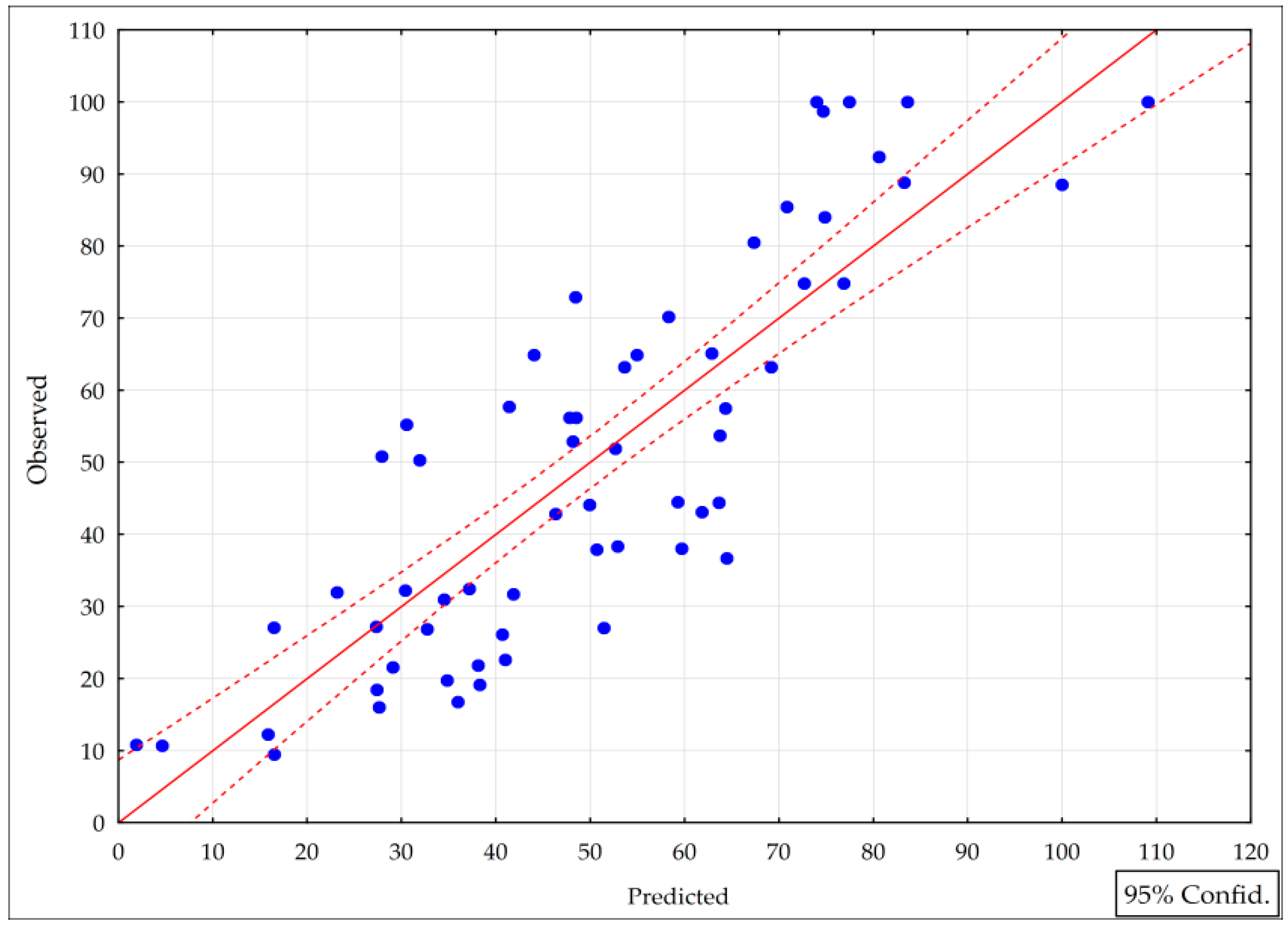

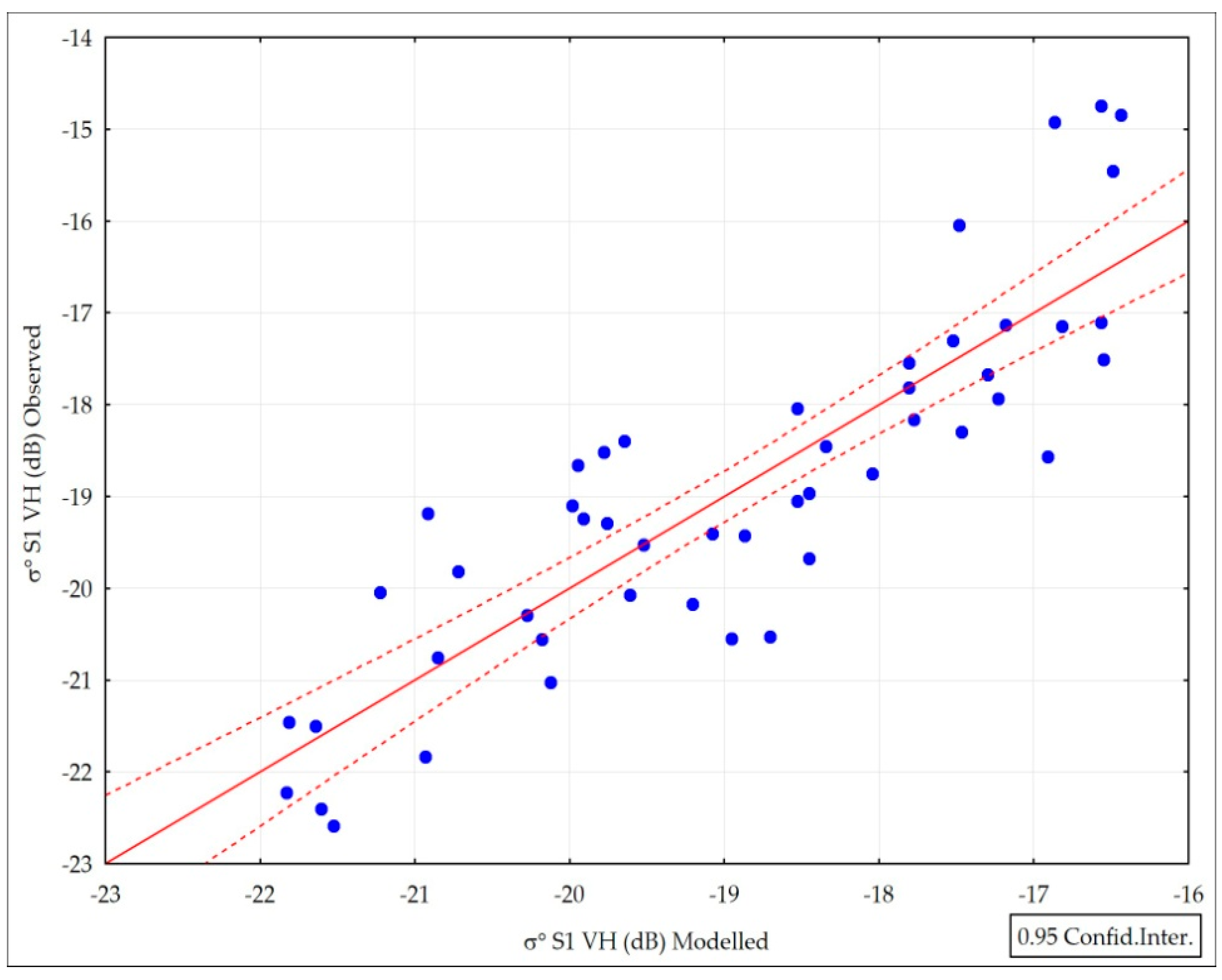
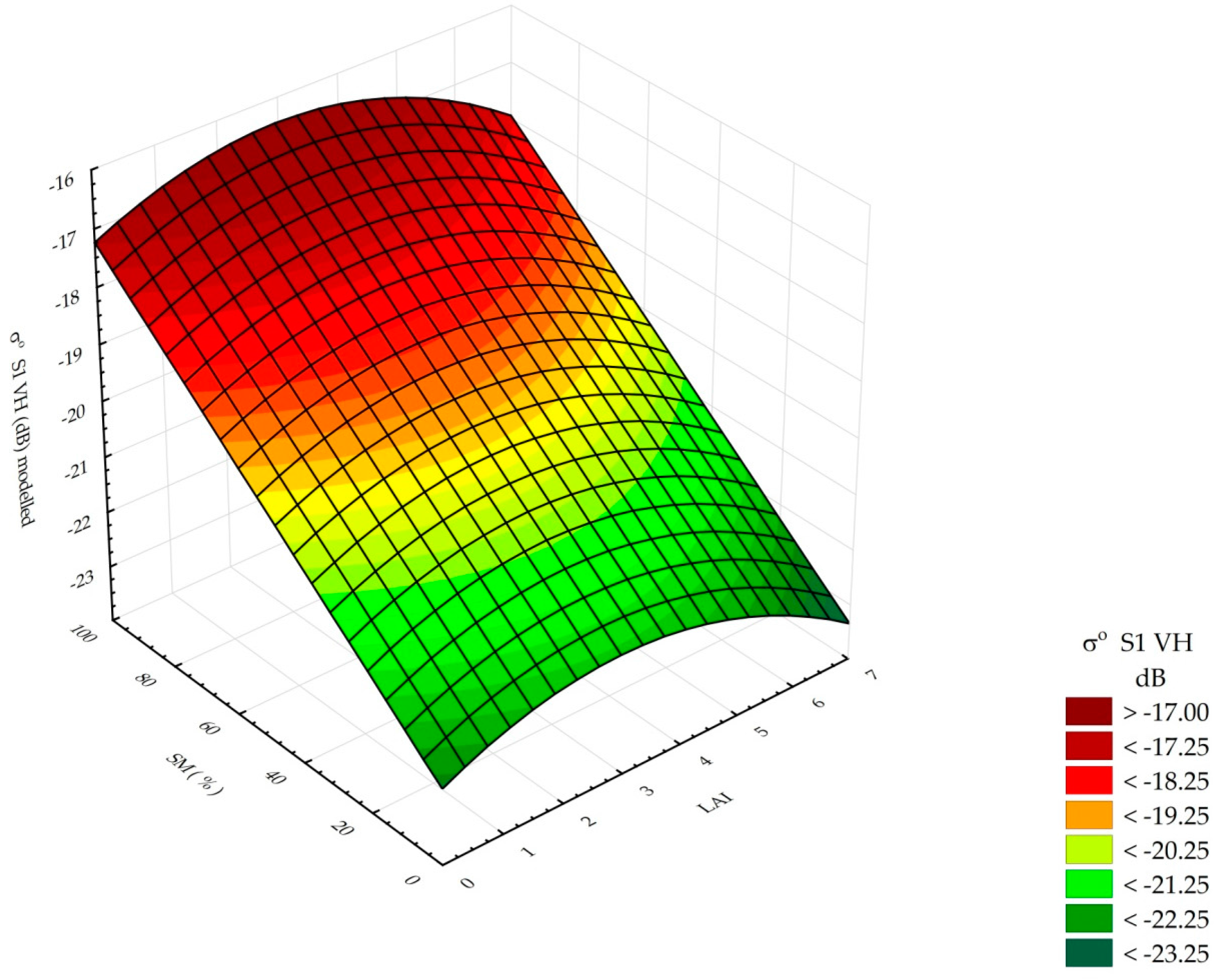
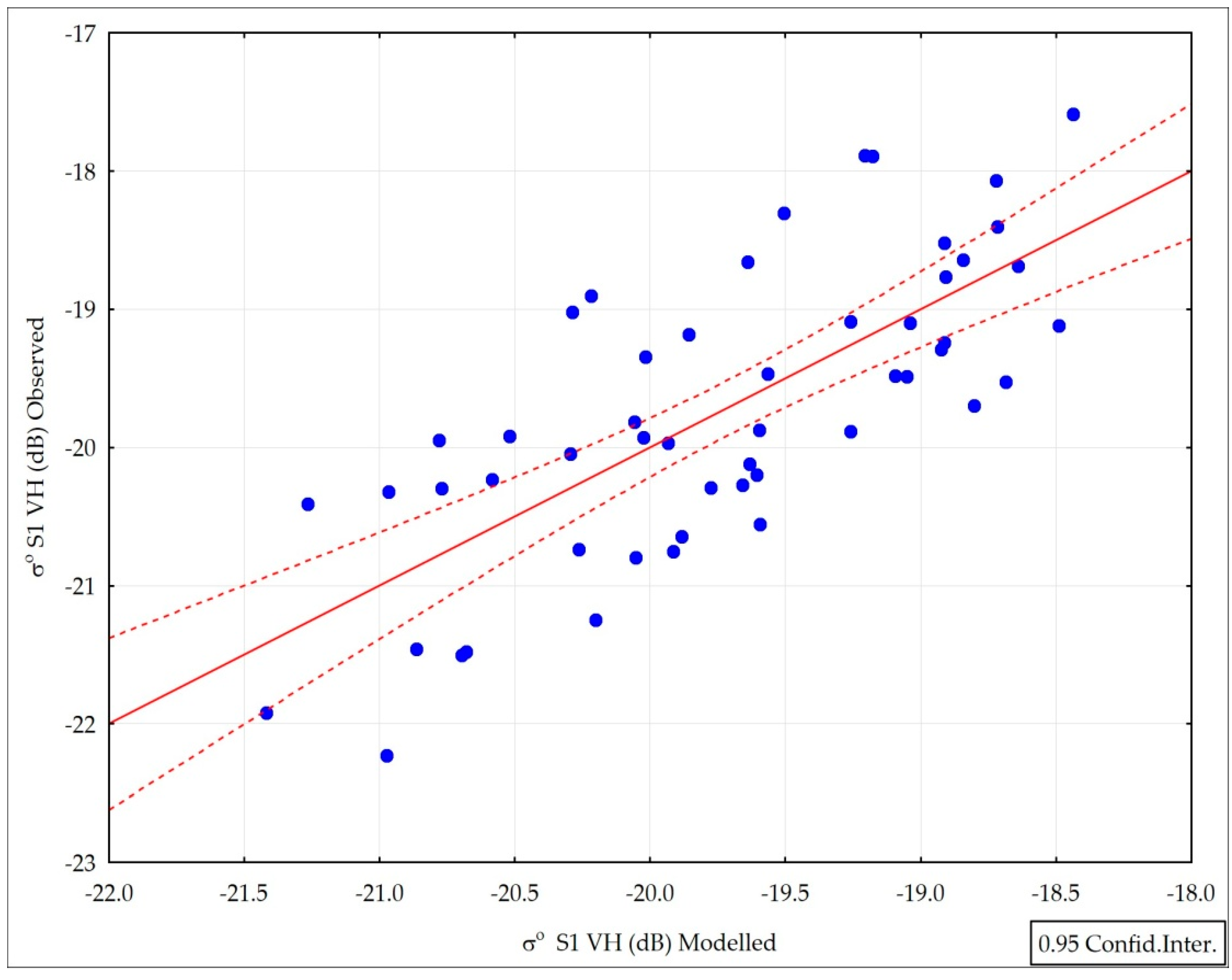
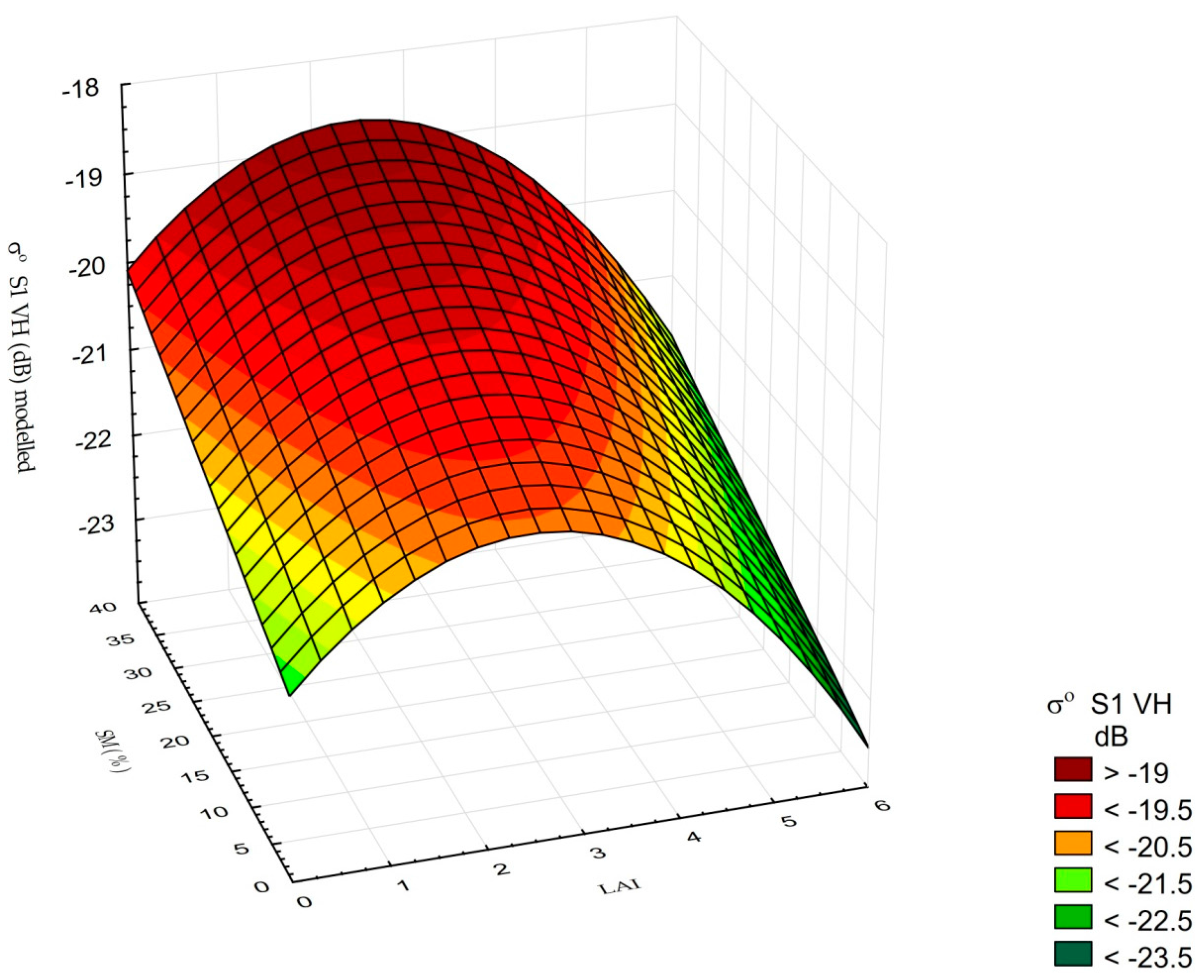
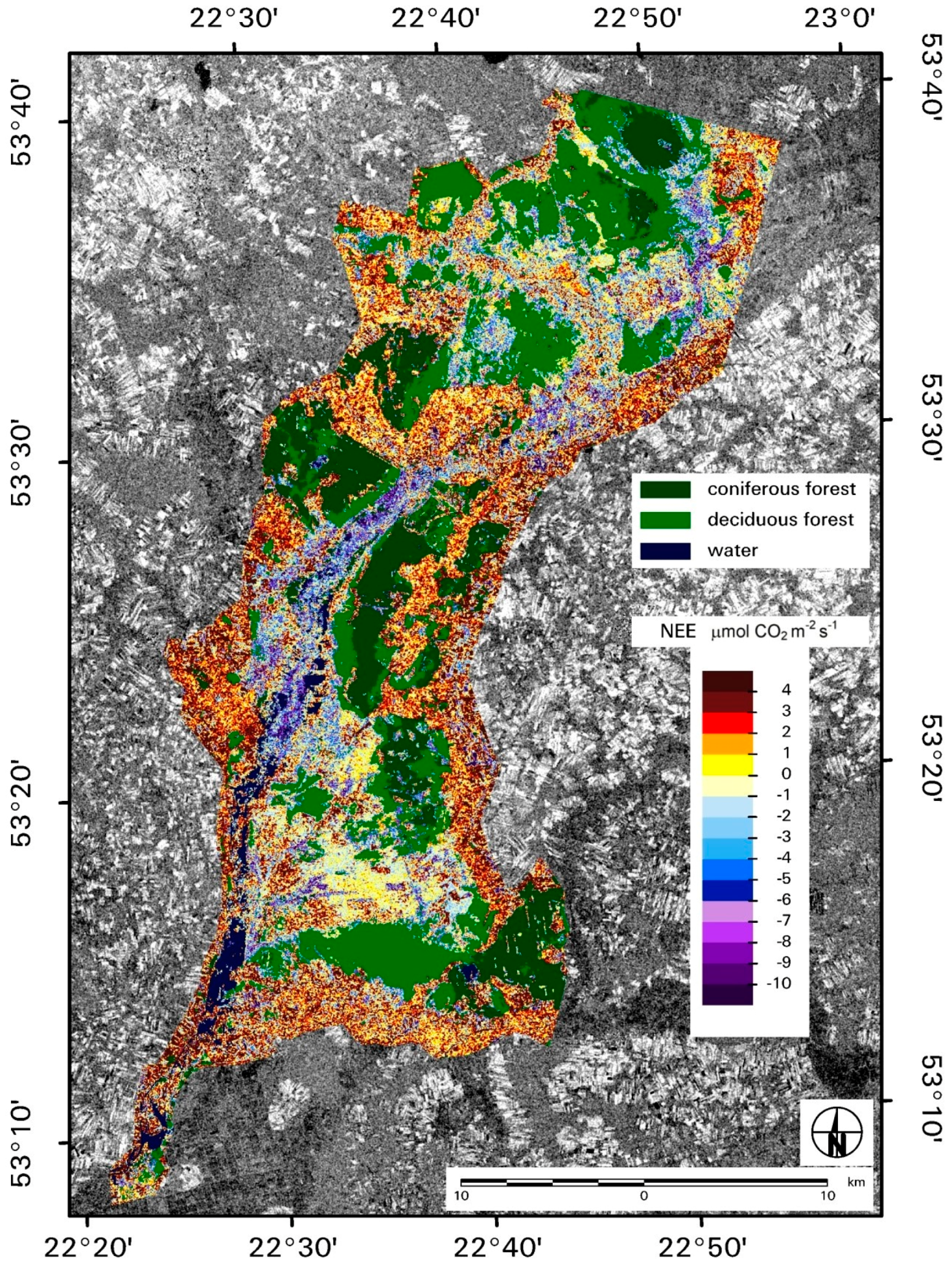
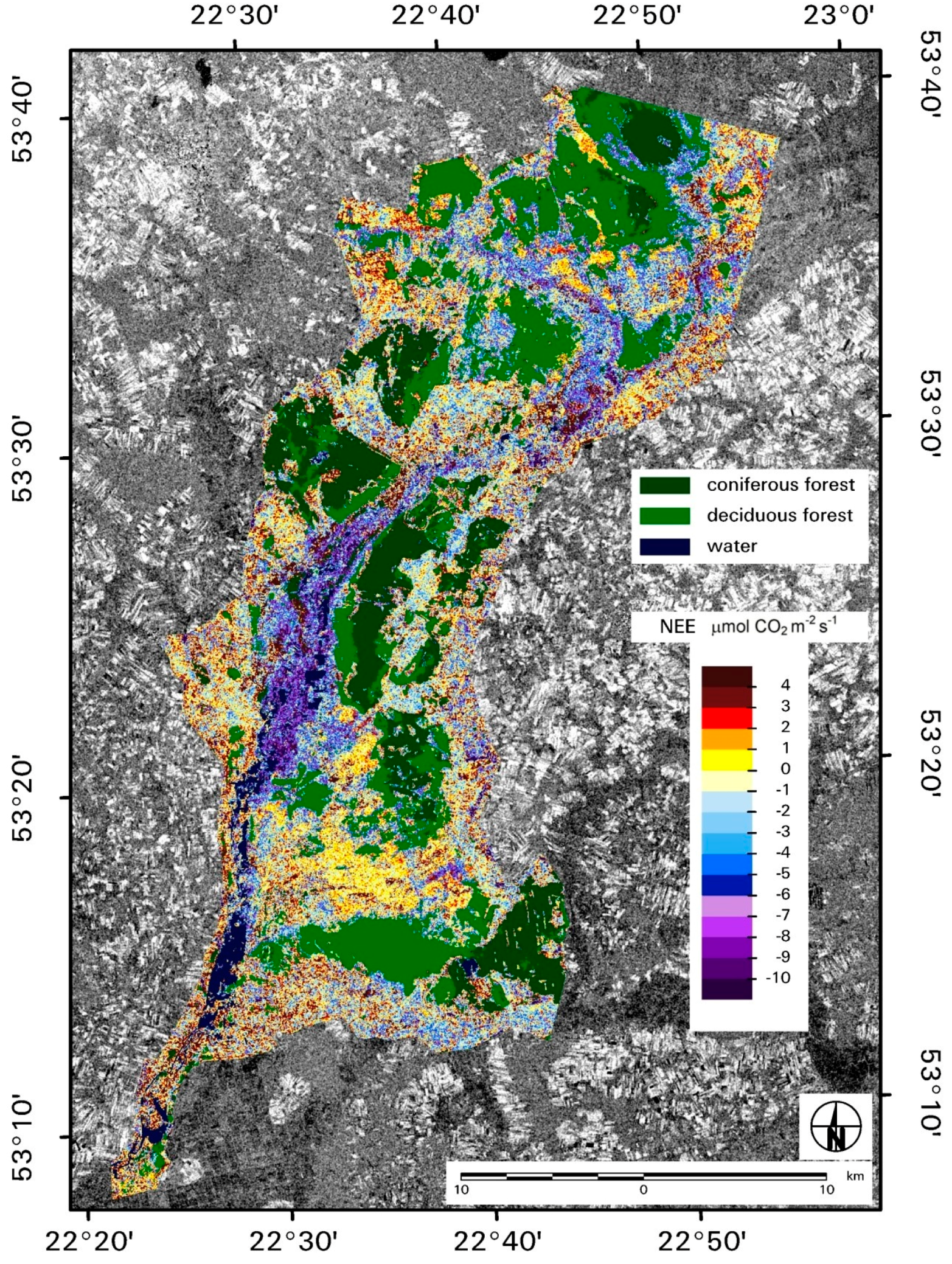
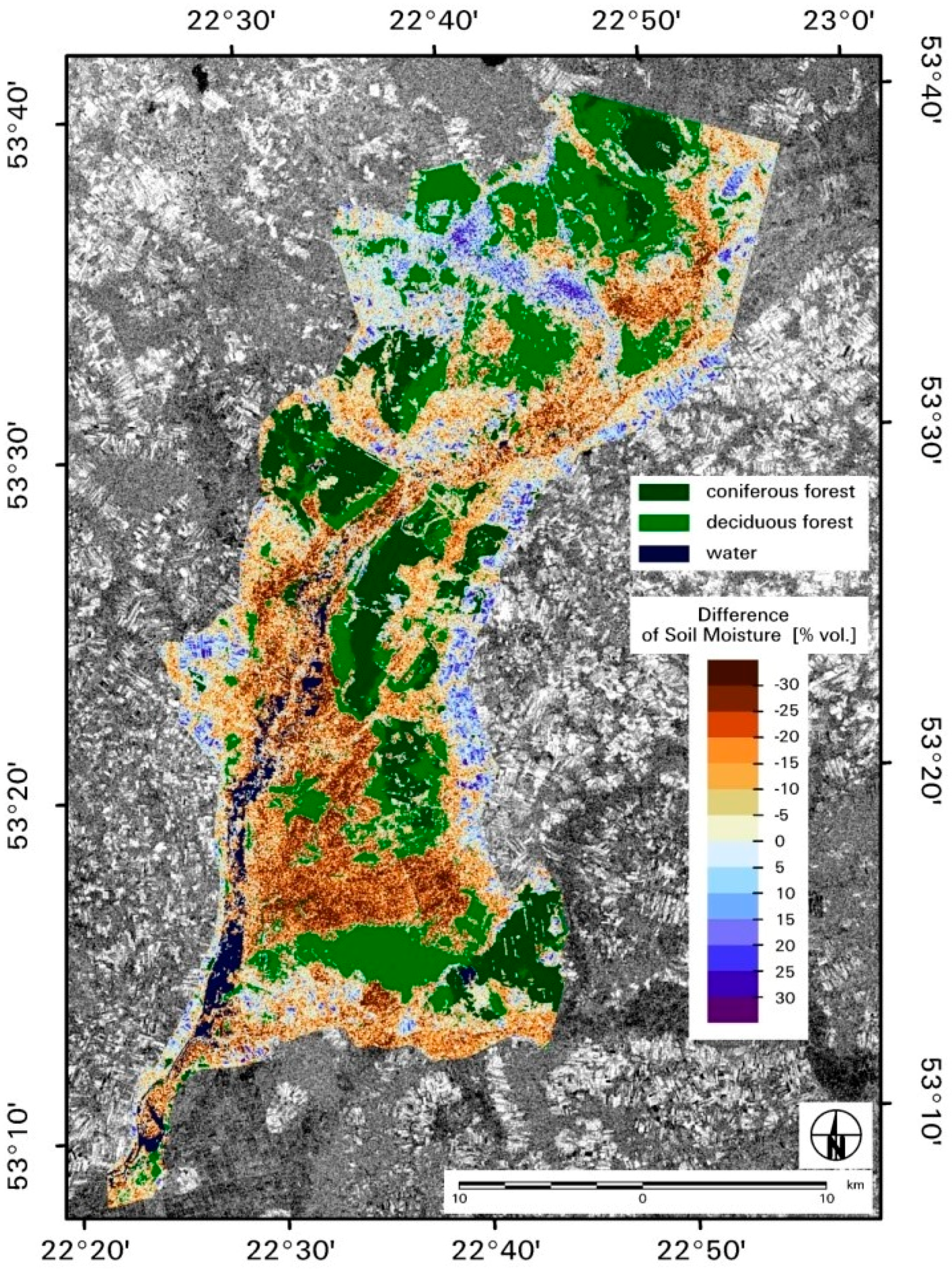
| Platform Sensor Mode | Band (cm) | Acquisition Date | Processing Level/Type | ENL 1 | Beam Track | Spatial Resolution (m) | Polarization |
|---|---|---|---|---|---|---|---|
| TerraSAR-X SAR ScanSAR | X 3.1 | 21 May 2013 | L1B GEC 2 | 1 | scan_008 | 18 | VV |
| 7 June 2013 | scan_003 | ||||||
| 23 June 2013 | scan_008 | ||||||
| Sentinel-1 SAR IW | C 5.55 | 31 October 2014 | L1 GRD 3 | 5 | 29 | 10 | VV/VH |
| 11 May 2015 | 29 | ||||||
| 11 June 2015 | 131 | ||||||
| 28 June 2015 | 29 | ||||||
| 10 July 2015 | 29 | ||||||
| 29 July 2015 | 131 | ||||||
| 15 August 2015 | 29 | ||||||
| 27 August 2015 | 29 | ||||||
| 20 September 2015 | 29 |
| Classified Data | Water | Coniferous Forest | Deciduous Forest | Sedge-Moss | Sedges | Grass-Herbs | Grass | Reeds |
|---|---|---|---|---|---|---|---|---|
| Water | 99.67 | 0 | 0 | 0 | 0 | 0 | 0 | 0 |
| Coniferous forest | 0 | 99.28 | 0 | 0.28 | 0 | 0 | 0 | 0 |
| Deciduous forest | 0 | 0 | 99.51 | 0 | 0 | 0 | 0 | 0 |
| Sedge-moss | 0.33 | 0.5 | 0.3 | 92.13 | 8.23 | 0.63 | 0 | 3.58 |
| Sedges | 0 | 0 | 0.08 | 5.2 | 91.06 | 0 | 0 | 0.63 |
| Grass-herbs | 0 | 0.03 | 0.05 | 0.98 | 0.08 | 98.68 | 0 | 0 |
| Grass | 0 | 0 | 0.06 | 0.35 | 0.03 | 0.4 | 100 | 0 |
| Reeds | 0 | 0.19 | 0 | 1.05 | 0.6 | 0.29 | 0 | 96.79 |
| Class Name | Reference Totals | Classified Totals | Number Correct | Producers Accuracy (%) | Users Accuracy (%) |
|---|---|---|---|---|---|
| Water | 6 | 6 | 6 | 100 | 100 |
| Coniferous forest | 16 | 17 | 16 | 100 | 94.12 |
| Deciduous forest | 31 | 26 | 26 | 83.87 | 100 |
| Sedge-moss | 21 | 31 | 21 | 100 | 67.74 |
| Sedges | 12 | 8 | 8 | 66.67 | 100 |
| Grass-herbs | 14 | 15 | 12 | 85.71 | 80 |
| Grass | 10 | 9 | 9 | 90 | 100 |
| Reeds | 5 | 3 | 3 | 60 | 100 |
| Platform Sensor | Habitat | R2 | St. Error of Est. | Number of Data | p-Value | Equation |
|---|---|---|---|---|---|---|
| Sentinel-1 IW VH | Reeds | 0.71 | 14.35 | 29 | 0.0000 | SM = 233.791 + 9.805 × σ° |
| Sedge-moss | 0.76 | 11.23 | 30 | 0.0000 | SM = 278.537 + 11.898 × σ° | |
| Sedges | 0.76 | 11.15 | 41 | 0.0000 | SM = 218.194 + 8.586 × σ° | |
| Grass-herbs | 0.70 | 7.01 | 33 | 0.0000 | SM = 130.341 + 5.271 × σ° | |
| Grass | 0.75 | 6.14 | 49 | 0.0000 | SM = 136.539 + 5.253 × σ° |
| Platform Sensor | Habitat | R2 | Standard Error of Est. | Number of Data | p-Value | Equation |
|---|---|---|---|---|---|---|
| Sentinel-1 IW VV | all | 0.63 | 15.28 | 58 | 0.0000 | SM = 235.666 + 14.980 × σ° |
| Sentinel-1 IW VH | all | 0.72 | 14.32 | 62 | 0.0000 | SM = 347.273 + 15.413 × σ° |
| Habitat | R2 | St. Error of Est. | Number of Data | p-Value | Equation |
|---|---|---|---|---|---|
| Reeds | 0.66 | 0.32 | 116 | 0.0000 | LAI = 0.077Bw0.533 |
| Sedge-moss | 0.67 | 0.29 | 149 | 0.0000 | LAI = 0.041Bw0.646 |
| Sedges | 0.70 | 0.36 | 112 | 0.0000 | LAI = 0.023Bw0.722 |
| Grass-herbs | 0.67 | 0.37 | 214 | 0.0000 | LAI = 0.016Bw0.787 |
| Grass | 0.69 | 0.34 | 207 | 0.0000 | LAI = 0.022Bw0.749 |
| Platform Sensor | Habitat | R2 | Standard Error of Est. | p-Value | Equation |
|---|---|---|---|---|---|
| Sentinel-1 IW VH VV | Reeds | 0.57 | 2.75 | 0.0043 | NEE = −42.85 − 4.25 × σ°S1VH + 2.71 × σ°S1VV |
| Sedge-moss | 0.58 | 2.02 | 0.0057 | NEE = −7.22 + 1.42 × σ°S1VH − 2.74 × σ°S1VV | |
| Sedges | 0.51 | 1.57 | 0.0024 | NEE = −2.28 − 0.86 × σ°S1VH + 1.08 × σ°S1VV | |
| Grass-herbs | 0.51 | 2.75 | 0.0072 | NEE = 27.75 + 1.87 × σ°S1VH − 0.65 × σ°S1VV | |
| Grass | 0.55 | 3.07 | 0.0001 | NEE = 11.22 + 2.34 × σ°S1VH − 2.72 × σ°S1VV |
© 2016 by the authors; licensee MDPI, Basel, Switzerland. This article is an open access article distributed under the terms and conditions of the Creative Commons Attribution (CC-BY) license (http://creativecommons.org/licenses/by/4.0/).
Share and Cite
Dabrowska-Zielinska, K.; Budzynska, M.; Tomaszewska, M.; Malinska, A.; Gatkowska, M.; Bartold, M.; Malek, I. Assessment of Carbon Flux and Soil Moisture in Wetlands Applying Sentinel-1 Data. Remote Sens. 2016, 8, 756. https://doi.org/10.3390/rs8090756
Dabrowska-Zielinska K, Budzynska M, Tomaszewska M, Malinska A, Gatkowska M, Bartold M, Malek I. Assessment of Carbon Flux and Soil Moisture in Wetlands Applying Sentinel-1 Data. Remote Sensing. 2016; 8(9):756. https://doi.org/10.3390/rs8090756
Chicago/Turabian StyleDabrowska-Zielinska, Katarzyna, Maria Budzynska, Monika Tomaszewska, Alicja Malinska, Martyna Gatkowska, Maciej Bartold, and Iwona Malek. 2016. "Assessment of Carbon Flux and Soil Moisture in Wetlands Applying Sentinel-1 Data" Remote Sensing 8, no. 9: 756. https://doi.org/10.3390/rs8090756
APA StyleDabrowska-Zielinska, K., Budzynska, M., Tomaszewska, M., Malinska, A., Gatkowska, M., Bartold, M., & Malek, I. (2016). Assessment of Carbon Flux and Soil Moisture in Wetlands Applying Sentinel-1 Data. Remote Sensing, 8(9), 756. https://doi.org/10.3390/rs8090756






